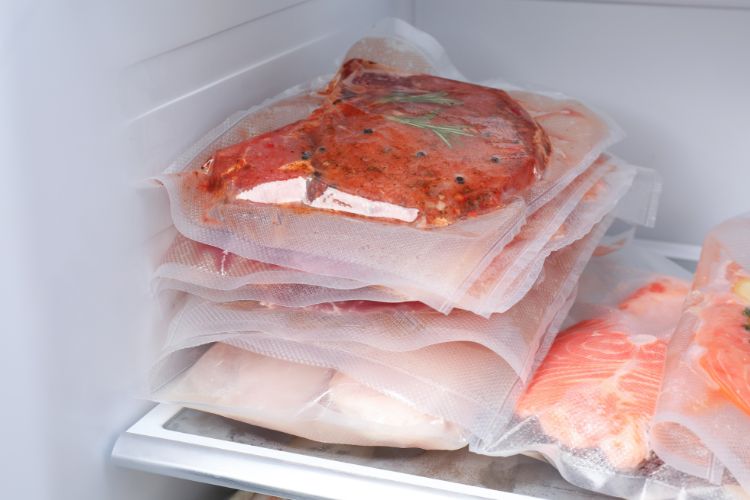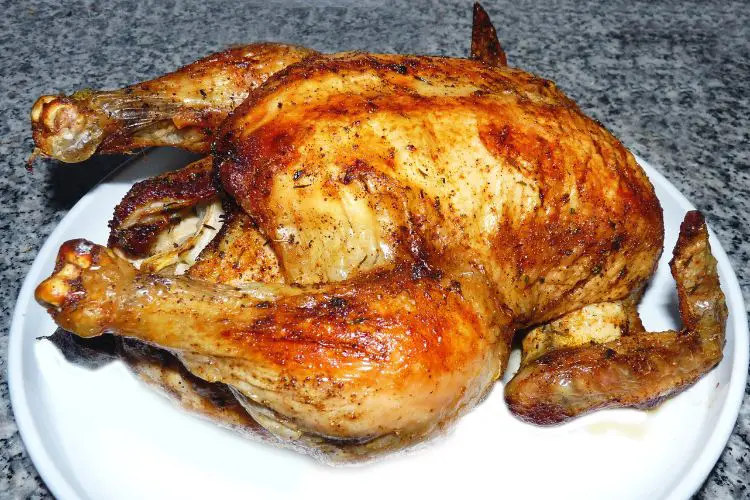Rotisserie chicken is a very popular meal option around the world. Its captivating smell and juicy flavor frequently keep people coming back for more, whether you’re buying one up from your neighborhood grocery store for a convenient supper alternative or cooking one at home for a weekend feast.
Nevertheless, despite how delicious it is, it also raises a question How long is rotisserie chicken good for? When it comes to perishable foods like chicken, food safety is the top priority. We want to walk you through every step of rotisserie chicken storage, preservation, and spoiling detection in this article. This article will also explain how to preserve the mouthwatering taste of your chicken while making sure it’s safe to eat.
History of Rotisserie Chicken
Rotisserie cooking has ancient roots. It goes back to medieval times. Back then, people turned meat slowly over a fire. They used their hands or a simple crank. This method ensured the meat was evenly cooked and remained juicy.
The love for rotisserie chicken first blossomed in France. There, it got the name “poulet rôti.” The French adored its simple, juicy taste.
By the time the 20th century rolled around, technology had advanced. Electric rotisseries came into the picture. This made the cooking process even more straightforward.
In the 1990s, a trend started in the U.S. Supermarkets began selling pre-cooked rotisserie chickens. They often priced them low to lure in customers. Now, these tasty birds are a staple worldwide, praised for both their flavor and convenience.
The Importance of Proper Food Storage

Maintaining the quality, taste, and safety of our meals depends on proper food storage. It contributes to the preservation of food’s freshness, increases its shelf life, and protects against foodborne infections.
Rotisserie chicken is one perishable that is particularly prone to bacterial development when not stored properly.
Poultry frequently contains bacteria like Salmonella and Campylobacter, which can multiply quickly at room temperature and raise the possibility of food poisoning. It is crucial to use proper food storage procedures because the signs of foodborne infections can range from minor discomfort to serious problems needing hospitalization.
Immediate refrigeration is essential when it comes to preserving rotisserie chicken. Chicken should be stored in the refrigerator within two hours of cooking or purchasing. Additionally, keeping your refrigerator’s temperature below 40°F (4°C) helps prevent the formation of bacteria and keeps your chicken safe for consumption for a longer amount of time.
The use of the appropriate containers is another aspect of proper food storage. Cross-contamination can be avoided while maintaining the flavor and quality of your chicken using airtight containers or strong freezer bags. Being aware of and using safe food storage practices benefits both our health and the quality of our overall dining experience. We can take full use of meals like rotisserie chicken by maintaining their flavor and quality.
How Long Rotisserie Chicken Can Last in the Fridge

To guarantee that rotisserie chicken is safe and of high quality for eating, it is essential to understand how long it will remain fresh. A rotisserie chicken is best eaten immediately while it’s still hot from the oven. This is the time when the texture and flavor are at their best. Try to eat a warm rotisserie chicken you bought from the grocery store within two hours.
The refrigerator is the next best place for storing your rotisserie chicken if you can’t eat it immediately. Cooked chicken can be stored in the fridge for 3–4 days. Although it may start to dry out a little at the end of this time, it should retain most of its flavor and texture over this time. To keep it fresh and avoid contamination, you should always store it in an airtight container.
However, it’s important to keep in mind that while freezing can maintain the chicken’s safety, it could somewhat change its texture and flavor, especially if kept for a long time. The freshness of your rotisserie chicken may also depend on other factors, such as the temperature of your refrigerator or freezer and how the chicken has been handled before storage. Keep in mind that these time frames are only guidelines. You must be cautious and eliminate any chicken that smells bad, looks discolored, or feels sticky.
Also Read: How Long to Cook Thin Chicken Breast in Oven at 400
Signs that Rotisserie Chicken Has Gone Bad
To prevent potential foodborne infections, it is essential to recognize rotten chicken. Changes in scent, color, and texture are typically indicators that a rotisserie chicken has gone bad.
Chicken that has gone bad usually smells bad first. The aroma of fresh chicken is subtle or light. Your chicken is probably destroyed if it has an unpleasant odor that is frequently described as “sour,” “rotten,” or “ammonia-like.” Never overlook an unpleasant or off-smelling smell because it usually indicates bacterial growth.
Potential Risks of Consuming Spoiled Chicken
Foodborne infections or food poisoning, can cause major problems with your health if you consume rotten chicken. Different microorganisms that flourish on improperly stored chicken are the root of many diseases.
Salmonella and Campylobacter are two of the most typical bacteria discovered in rotten chicken. Both of them can cause severe gastroenteritis symptoms like diarrhea, abdominal cramps, fever, nausea, and vomiting. In severe situations, these symptoms might cause dehydration and necessitate hospitalization. They can persist anywhere from a few hours to several days.
Infected chicken can also include dangerous microorganisms like Clostridium perfringens and Staphylococcus aureus, which can cause similar debilitating symptoms. In rare cases, eating rotten chicken can lead to more severe illnesses, like kidney failure-causing Hemolytic Uremic Syndrome. Proper food handling, storage, and monitoring for rotting symptoms are the greatest means of protection against these possible threats.
Tips for Extending the Shelf Life of Rotisserie Chicken
Rotisserie chicken’s flavor and freshness can be preserved for a longer period of time with proper storage methods and some additional tips. Let’s check out some essential tips to keep the freshness and flavor of the chicken.
Immediate Refrigeration
You should put your rotisserie chicken in the refrigerator as soon as possible. It is one of the crucial steps in extending its shelf life. To prevent bacterial growth, it is recommended to store the chicken in the refrigerator within two hours of cooking or purchasing.
Proper Packaging
It matters how you store your chicken and how it is packaged. The chicken should be kept in sealed containers or strong freezer bags. These shield your food from contamination from other foods in your refrigerator or freezer as well as exposure to air, which can cause your chicken to dry out.

Divide into Portions
Consider cutting up a large chicken into smaller chunks before freezing or refrigerating it if it won’t be eaten all at once. In this way, you may simply remove the quantity you require without defrosting the whole chicken.
Freezing for Longer Storage
Freezing your rotisserie chicken is a fantastic choice for longer storage. Rotisserie chicken can be stored in the freezer for up to four months if it is properly packed and sealed.
Reheating Properly
Make sure the chicken is properly warmed before serving. To eliminate any potential microorganisms, heat it up to an internal temperature of 165°F (74°C).
FAQs
Can you eat rotisserie chicken after 5 days in the fridge?
Although rotisserie chicken may possibly be eaten after five days in the refrigerator, it’s usually safest to eat it within three to four days. Quality, flavor, and safety can begin to decline after five days. Always check for degradation using your senses. It is preferable to throw away chicken if it smells bad, has changed color, or has a slimy texture in order to prevent foodborne infections.
Can you freeze rotisserie chicken immediately?
Rotisserie chicken can be frozen right away after purchase to increase shelf life. However, it’s recommended to let the chicken cool down first for maximum safety and to avoid raising the temperature in your freezer. When it has cooled, wrap it tightly in materials that can withstand freezing or put it in airtight containers. Then, store it in the freezer where it may be kept for a while.
How do you properly reheat rotisserie chicken?
You can use an oven to properly reheat rotisserie chicken. Place the chicken in a baking dish and preheat the oven to 350 degrees. You can add a small bit of water or chicken stock to keep it moist. Heat the casserole for roughly 20 to 30 minutes, or until the chicken is well-heated. By using this technique, the chicken’s flavor is preserved and it doesn’t dry out.
Can I use the bones of the rotisserie chicken?
Yes, you may make homemade chicken stock or bone broth using rotisserie chicken bones. Simply add the bones to a saucepan along with water, some of your favorite herbs, and some veggies like onions, carrots, and celery. Then, drain it after letting it simmer for a few hours. The stock or broth can be saved for later use or stored in the freezer for several months. It may also be eaten immediately.
Is it safe to eat cold rotisserie chicken?
Yes, if the rotisserie chicken has been properly stored and chilled, then eating it cold is safe. In order to stop the growth of bacteria, the chicken should be refrigerated within two hours of cooking or purchasing it. Cold rotisserie chicken is commonly eaten in salads, sandwiches, and even straight from the refrigerator. Always look for indicators of deterioration, such as odd scents, colors, or textures, before eating.
In a Nutshell
Understanding the rotisserie chicken’s shelf life and taking the required precautions to store it properly will substantially improve your dining experiences while protecting you from any foodborne illnesses. By using the information provided in this article, you can plan your meals more effectively and waste less food while still maintaining the great flavor of your chicken.
You should be familiar with the ideal methods for keeping and reheating your rotisserie chicken, as well as the warning indications of deterioration. You should always maintain caution when it comes to food safety. Any chicken that might have gone rotten should be thrown away. Rotisserie chicken’s tasty flavor and adaptability are the major two factors that contribute to its popularity. To make sure that every taste is as delicious and secure as the last, you must know how to handle it safely.

